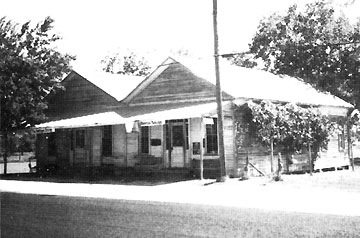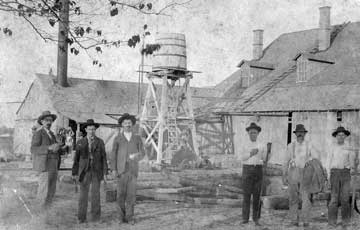Ammannsville, Texas
by Carolyn Heinsohn
The sleepy little village of Ammannsville, Texas, located approximately eleven miles south of La Grange, once was a thriving community filled with a variety of businesses, in addition to a fraternal lodge hall, a Catholic Church and a number of different schools. Intersected by FM Rd. 1383 that meanders from Hwy 77 South through Ammannsville and Dubina to Hwy 90 A, the community now is a mere shadow of its early days, when local farmers brought their cotton to the gins, traded in the stores, gathered together for social events at the lodge hall and worshipped at the church on Sundays.
Surrounded by rolling hills with pastures and an occasional grove of trees, the area just west of Ammannsville was first settled by Andrew Ammann, a native of the Empire of Austria, who received his architectural training and certification in Switzerland. He immigrated to the United States circa 1843 and made his way to La Grange, where he assisted with the design and construction of the first Fayette County jail. In early 1870, he purchased 300 acres of land in the W.A. Hall League between present-day Ammannsville and Swiss Alp. The two communities both owe their names to Ammann – one directly linked to his name, and the other in memory of his place of education.
Immigrant Czech and German settlers looking for suitable farm land began arriving in the area in the 1870s and 1880s. By 1890, Ammannsville, with its predominantly Czech population, had grown into a fairly sizeable community. It was the seat of Precinct 7, had a precinct courthouse, a small jail and was served by ten justices from 1876 to 1950, when the precinct was abolished. The courthouse and jail buildings were later sold and moved.
Since the majority of the settlers were farmers, and cotton was the principal cash crop, a cotton gin was one of the first businesses to be built in the area in 1870. By 1877, three gins were built in the community with the most successful one operated by Theofil Heller, Sr., who was a native of Alsace-Lorraine. The gins changed owners and locations through the years, as well as having progressed from wood-fired steam operations to gasoline engines. The only remaining gin building, that closed its doors in 1960, is the one that was owned and operated by Willie Bohuslav, Sr. – it stands as a silent reminder of the bustling days of ginning when “Cotton was King”.
By 1877, Henry Hoelster had opened a saloon where the present-day KJT Hall is located. The property was eventually sold in 1923 to the KJT fraternal organization for their new lodge hall. The hall not only provided a meeting place for the organization, but also a great venue for a variety of social activities, primarily dances, which were the favorite form of entertainment for the local residents. Weddings, reunions, funeral dinners and the annual church feast held every Father’s Day are still being held in the same hall that has had some renovations and additions.
The oldest general mercantile store, which included a dance platform, was built by Eckert Stuarcke in 1885. He later sold it to Josef Vacek, Jr., who advertised his business in 1902 as the “Oldest General Merchandise Business in Ammannsville with a first class saloon and fine hall for dancing with theatrical performances that have established a reputation in the southern half of Fayette County.” The post office, which was also located in the store, was discontinued in 1906. Thereafter, Ammannsville was a mail route of Weimar until the 1920s, when it was switched to Schulenburg. Today some parts of the area are served by the La Grange post office.
Josef Vacek, Jr. also advertised stud services with his thoroughbred stallion, Boss, and his Kentucky Jack. After selling his business to John F. Cernosek, L.G. Bartos and J.M. Bartos, he moved to Dubina where he farmed until moving to Weimar, Texas. John A. Bartosh (name change), who bought the business from his father in 1927 and became the leading merchant in town, also bought and sold cotton and turkeys. When Mr. Bartosh died in 1984, the business closed, but the building is still standing in relatively good condition.
J.V. Dobrava erected another general merchandise store and dance platform in 1895. It eventually was sold to F.J. Parma, an emerging leader in the community, who later helped found the First State Bank of Ammannsville, which was located next to his store. After Parma’s death, the institution was operated by several other family members until the stock market crash of 1929, when the bank was forced to close. The general merchandise store was eventually purchased by Albert J. Cernosek, who operated it as a grocery store and meat market until 1967. The dilapidated building is still standing, surrounded by encroaching vegetation.
There was a previous meat market operated by Emil and Joe Barta, who also operated a hammer mill at his farm. An automotive garage was built by Adolf J. Kristek in 1916. The last owner was R.B. Jasek, who operated the garage until 1956.
Blacksmiths were an absolute necessity in every community in the earlier days when implements and tools had to be made, and horseshoes were essential. The first village blacksmith was a Mr. Naiser, who sold his business to John Kocurek. Other smithies were owned by John Krupa, John Sumbera, Ed Rabel and Fred Rabel, the last known blacksmith in Ammannsville, who closed his business in 1966.
 The J. V. Bartos Drug Store in Ammannsville, Texas;
|
The community was served by at least eight different physicians, beginning with Dr. Holman and ending with Dr. Lewis. Although some practiced in their homes, and others took care of patients in the doctor’s office in Ammannsville, they all made house calls. An advertisement in 1902 in F. Lotto’s history on Fayette County stated: “Dr. John S. Zvesper, Ammannsville, Texas, is prepared to treat cases of alcoholism and diseases of women at his residence….telephone connection with all points in county and state.”
There were also midwives in the area, including Magdalena Vacek, wife of Josef Vacek. She delivered a fairly large number of babies in the community from the time of her arrival in 1876 until old age affected her ability to continue.
Two brothers, Louis and Innoc Tofel, now deceased, opened the last remaining commercial business in Ammannsville in 1949. Known as Tofel’s Place, the beer joint has been a popular place to quench one’s thirst or play a game of dominoes. The original building was sold and moved to a private farm; however, due to popular demand, Innoc purchased another similar building and re-opened his business, which is currently being operated by George Tofel.
The Fietsam family operated a molasses press for the local farmers for three generations. Joseph J. and wife, Ida, started their mule-driven operation in 1914. Their son, Arnold, continued operating the business with his wife, Irma, until they retired in 1970. However, they updated the system for cooking molasses several times throughout the years. It was not uncommon for them to cook approximately 3,000 gallons of molasses every year during sorghum cane season. They were occasionally assisted by their grown children in later years.
Regardless of which approach is chosen to enter Ammannsville, the first landmark that one sees is the steeple of the St. John the Baptist Catholic Church, which is the only church in the community. Ammannsville is one of four totally Catholic communities in Fayette County. The other three are Praha, Hostyn and Dubina. The present church is the third at that location.
The early Catholic settlers attended services at Bluff (Hostyn) or Dubina. In 1889, the area Catholics decided to build their own church. Eleven and one-quarter acres of land were donated by Peregrin Fiser, Josef Vacek, Sr. and Theofil Heller for a church, school and cemetery. The small church, which was completed in 1890, was demolished by an inland hurricane in 1909. Wood salvaged from the church was used to construct a rectory for the priest, and a new church was erected by November 1910. Disaster struck again when that church was completely destroyed by fire in October 1917. Six statues and a crucifix fortunately were rescued by area residents. Those items were placed in a newly-constructed church that was dedicated in December 1919. The beautiful Gothic-Revival church with its intricately painted decorative interior is now included in the popular “Painted Churches Tour”.
The adjacent cemetery has a number of artistic metal crosses and old ornate tombstones, many of which have Czech inscriptions that include the villages of origin of early immigrant settlers. The old rectory is now being renovated to be used as a venue for church-related activities.
There were a number of schools in Ammannsville, including public schools, a German school, a Czech school and Catholic parochial schools, all for grades 1-8. In the earlier days, older students rarely attended high school, because they were needed to help on the farms. A student would have had to leave home and board with someone in a larger town in order to attend high school. The schools were operational at different times depending upon the number of students attending and the financial backing. The school terms were based on planting and harvesting seasons. An interesting practice in the Ammannsville schools was the use of Catholic nuns in the public school for many years. The last school that existed was the Catholic parochial school that burned in 1954. Thereafter, the majority of the local children were bussed to St. Edward’s Catholic School in Dubina for five years until it closed in 1959, and thereafter to St. Rose Catholic School in Schulenburg. By that time, higher education was considered to be more of a necessity, so teenagers attended Bishop Forrest Catholic High School or the public high school in Schulenburg. Those living closer to La Grange attended high school there.
Today, any activity in Ammannsville revolves around the Catholic Church, the cemetery, the KJT Hall and Tofel’s Place. There are still a few local residents who enjoy their choice of a rural lifestyle in this quiet setting—a one stop-sign village seemingly caught in a time-warp.



